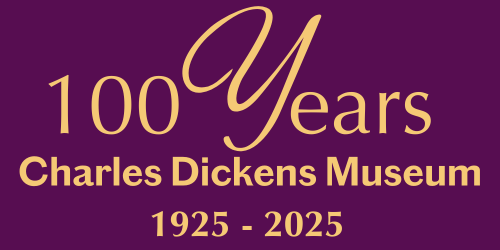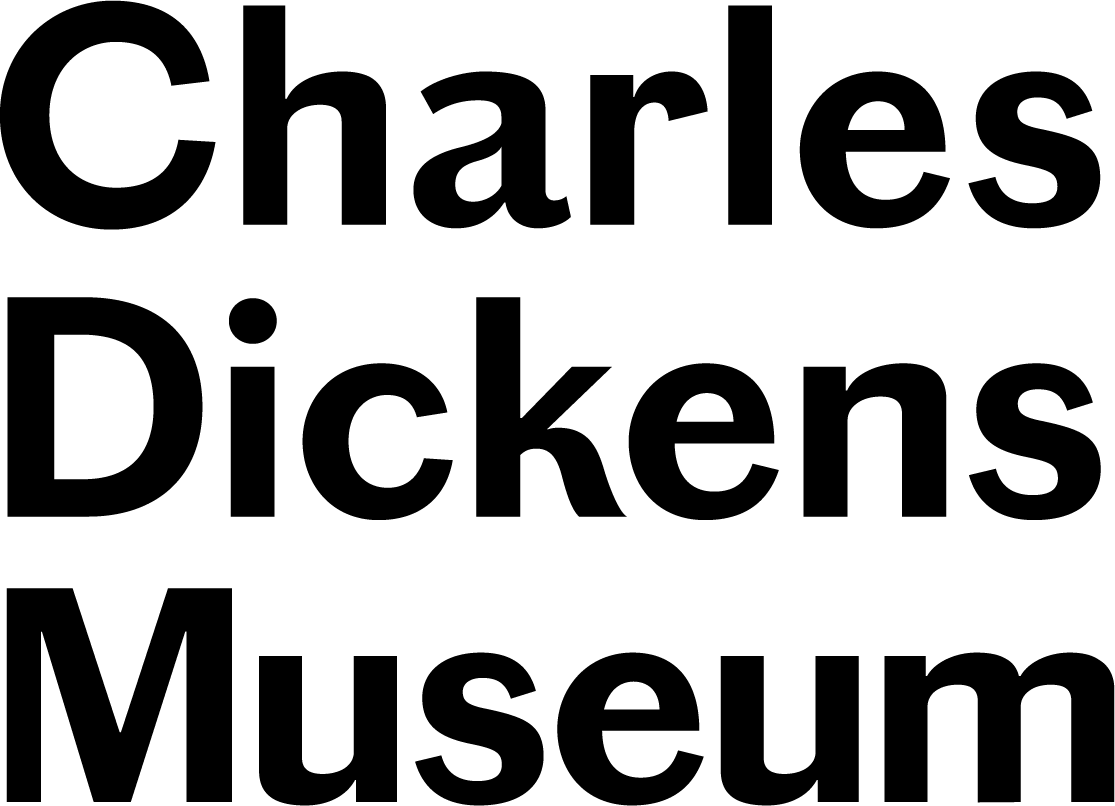For the love of Pickwick: Artist Anna Marongiu and the Pickwick Papers by Emma Treleaven
‘Marongiu’s taste for humorous and even caricatured images is indulged to the fill in this cycle, which interprets the cheerfully picaresque and libertarian spirit of Dickens’s novel’ 1
In 2019, the Charles Dickens Museum lent 262 illustrations of Charles Dickens’s first novel, The Pickwick Papers, to the MAN Museum in Sardinia. The illustrations were created by a then virtually unknown artist, Anna Marongiu.
Born in 1907 in Cagliari, Sardinia, Anna Marongiu showed a natural talent for narrative drawing from childhood. A very technically skilled artist, Marongiu used engraving, drawing and watercolours to great effect in her work, using her abilities to express places, people and above all characters with great emotive ability. Her characterful drawings became increasingly more accomplished, and by her mid 30s she was exhibiting her artwork in galleries in Sardinia. These shows included a retrospective solo exhibition at the Galleria Palladino located in the island’s capital, Cagliari, in 1938. Her life was cut tragically short when she died in a plane crash in 1941. Her home was destroyed during the Second World War, which almost erased all physical traces of the young artist, and this destruction of her archive coupled with her premature death has meant that until recently her work was all but almost forgotten.
From her surviving works, it seems Marongiu enjoyed illustrating dynamic crowd scenes, like circuses, and masterpieces of literature, such as William Shakespeare’s, A Midsummer Night’s Dream, and, most importantly for this blog, Charles Dickens’s, The Pickwick Papers.
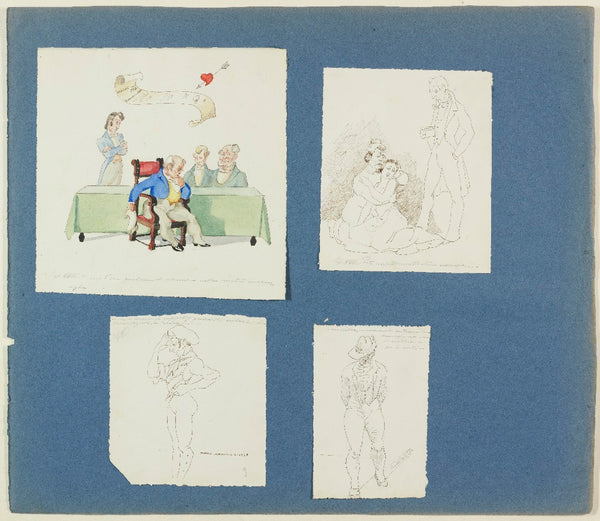 Anna Marongiu, 1928 illustrations, including a colour illustration showing Mr Pickwick receiving a letter from Dodson and Fogg, a sketched scene of Mrs Pott fainting in to the arms of her maid and another of Sam Weller. (DH774.1, Charles Dickens Museum collection)
Anna Marongiu, 1928 illustrations, including a colour illustration showing Mr Pickwick receiving a letter from Dodson and Fogg, a sketched scene of Mrs Pott fainting in to the arms of her maid and another of Sam Weller. (DH774.1, Charles Dickens Museum collection)
Marongiu created the 262 illustrations for The Pickwick Papers between 1928 and 1929, an enormous number considering these images only cover the first half of the story. Dickens scholar Michael Hollington has theorized that the translation of the novel it’s known Marongiu was working from was probably published in two volumes, so it’s possible she only had the first one in her possession. It’s also possible that she planned to return to The Pickwick Papers and finish her illustrations at another time, but sadly we will never know.
The illustrations seemingly were not commissioned and were never published, indeed no publisher at the time would have printed roughly 10 illustrations per chapter in the novel. So why did Marongiu take the time to produce so many works based on this Dickens novel? The Pickwick Papers, with its comic adventures, coming of age story, and darker, more gothic aspects all clearly appealed to the young artist, so perhaps these works were a passion project, created for the love of the novel.
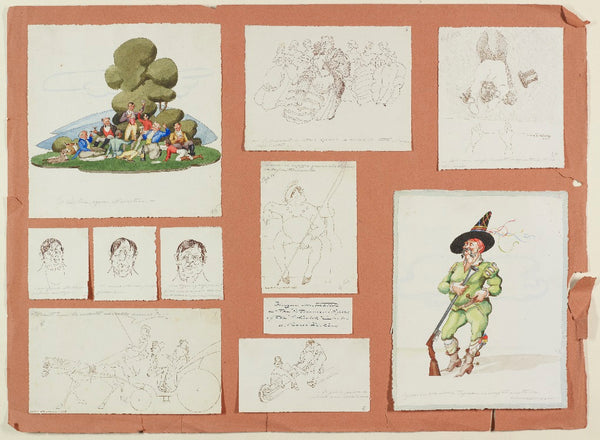 Anna Marongiu, 1928 illustrations, including colour illustrations of the Pickwick Club assembled and another of Mr Tupman in full brigand’s costume. (DH774.28, Charles Dickens Museum collection)
Anna Marongiu, 1928 illustrations, including colour illustrations of the Pickwick Club assembled and another of Mr Tupman in full brigand’s costume. (DH774.28, Charles Dickens Museum collection)
Most volumes of The Pickwick Papers published in English still use the original illustrations, but Marongiu joins a wealth of European illustrators to reinterpret Dickens’s stories. Even though her drawings were never published alongside the text, she is virtually unique in the history of Dickens illustrators due to the volume of illustrations created for one story but also the diversity of scenes she chose to illustrate. Marongiu was equally talented when it came to expressing the comedic, bright and joyful parts of the story, and the dark, gothic and haunting portions. Her work pulls the reader into the story, at times joyfully and times eerily, in the same way that Dickens’s words do.
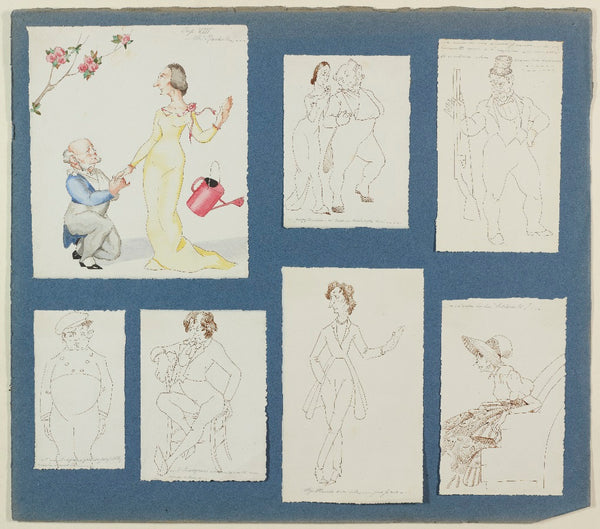 Anna Marongiu, 1928 illustrations, including a colour illustration of Mr Tupman on his knee to Rachael, as well as character sketches of Tupman, Winkle and Snodgrass. (DH774.3, Charles Dickens Museum collection)
Anna Marongiu, 1928 illustrations, including a colour illustration of Mr Tupman on his knee to Rachael, as well as character sketches of Tupman, Winkle and Snodgrass. (DH774.3, Charles Dickens Museum collection)
Anna Marongiu’s beautiful illustrations were donated to the Charles Dickens Museum in 1985 by her family. We know that the idea of an exhibition around her works was discussed in the late 1980s, but for unknown reasons it never materialised. While some of the illustrations were exhibited in 1938 as part of her solo exhibition, the retrospective exhibition at MAN in Nuoro, Sardinia, is the first time The Pickwick Papers series has been displayed together in its entirety.
While the exhibition has now closed and the artworks are safely back in the collections store at the Charles Dickens Museum in London, the exhibition lives on through online content, the beautiful exhibition catalogue (available online) and future research sparked by the MAN exhibition.
Short Film produced by Sardinia Film Commission Foundation in partnership with the MAN museum of Nuoro.
Emma Treleaven is the Assistant Curator at the Charles Dickens Museum. Her specialties include 20th century fashion and experimental making research methodologies. Prior to the Charles Dickens Museum, she worked at the Victoria and Albert Museum on the Dior: Designer of Dreams exhibition and at Bletchley Park.
1 Luigi Fassi, ‘Anna Marongiu: Story of a Rediscovery’, Anna Marongiu, Italy: Marsilio, 2019
Museum Blog
This blog takes you behind the scenes at the Charles Dickens Museum, giving fresh insight on everything from discoveries new and old in our collection, to exhibitions, events and learning initiatives.
You’ll be hearing from a variety of Museum staff and volunteers, as well as guest curators, academics, artists and Dickens enthusiasts. Why not join the debate and let us know you thoughts on the latest blog by using our hashtag #CDMBlog
